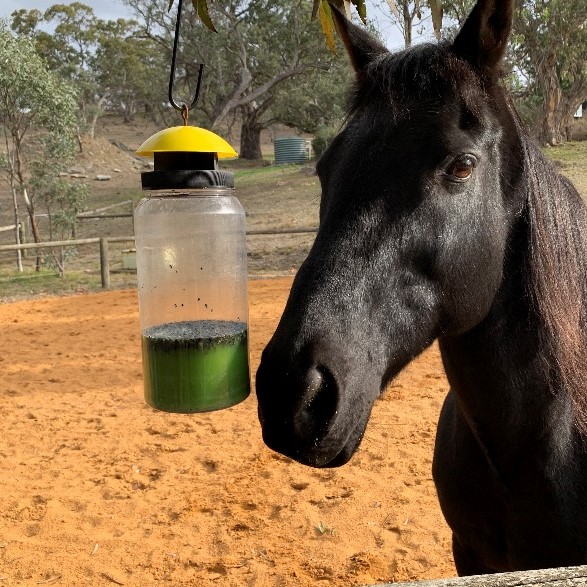What are filth flies? These are the species, such as house flies, blowflies or bushflies, that use manure, carcasses or rotting organic material for food. By moving between manure and the horse (feeding from eyes or scratches or wounds) they can easily spread disease, as well as causing the horse stress and discomfort from constantly buzzing around and landing on the horse.
While filth flies play a role in the rural ecosystem by breaking down organic matter and recycling nutrients, in large numbers they become pests and do need to be managed in an environmentally sensitive way. So, what can you do?
Understanding the lifecycle
First, it’s a good idea to understand where the flies are coming from. Before they reach the flying stage, flies have in fact undergone three earlier stages: eggs, larvae and pupae.
- Female flies lay 50 – 150 eggs every few days into manure, soiled animal bedding or rotting feed debris.
- The eggs hatch into larvae which feed for several days in that organic material.
- The larvae then bury into the soil and form a tough skin called a puparium around them.
- Within this, they metamorphose into the adult fly and eventually break out and wriggle out of the ground.
In summer this entire lifecycle can take as little as two weeks, which is why populations can build in number very quickly.
Control through environment management
By far the best way of managing fly numbers is to reduce their ability to reproduce through management of the environment. This is best done by paying attention to potential larval food supplies (ie moist organic material):
- Hay feeders: clean up old hay around feeders to avoid accumulations of decomposing matter.
- Stables: replace stable bedding weekly. Wood shavings and sawdust produce fewer flies than straw.
- Yards: clean up manure from yards at least twice per week.
- Pastures: harrow paddocks to break up manure heaps or collect manure regularly.
- Watering points: place waterers in well-drained areas away from where horses are fed. Repair leaks promptly.

Setting effective EnviroSafe fly traps early in spring will help keep the filth-fly populations in check as well. EnviroSafe traps catch the adult flies, removing them from the breeding population. The special Eco-bait is pesticide-free and the traps are re-usable. When full, just bury contents in the ground or your compost heap and re-set the trap with a new bait.
It is better to attack a fly problem when it is small, than to try to control it when it has become a major problem.
Physical barriers and repellents
During periods when flies are particularly numerous and active, it may be necessary to make use of fly masks, ear bonnets, or lightweight rugs to keep the flies away. These create a physical barrier to the flies but still allow freedom of movement and vision for the horse. A zebra-striped rug may be even more effective than the traditional style! Some fascinating recent research suggests that zebra stripes may disrupt the ability for flies to have a controlled landing. https://www.ucdavis.edu/news/how-zebra-stripes-disrupt-flies-flight-patterns/
Insect repellent lotions can also be applied for temporary relief from flies when the physical barriers need to be removed (for example during riding or handling of the horse).
Natural biocontrol agents – dung beetles and parasitic wasps.
Dung beetles can also help reduce filth fly populations by burying manure in the ground thereby making it unavailable for fly larvae to complete their development. If you can’t see dung beetles or their holes under manure in your paddocks, you can purchase them and introduce them onto your property. https://www.naturalresources.sa.gov.au/adelaidemtloftyranges/land/landholder-services/managing-soil-and-pastures/dung-beetle-benefits
Another insecticide-free, environmentally-friendly way of filth fly population control involves the use of stingless parasitic wasps, Spalangia wasps. These are a naturally-occurring biological control of house flies and they are harmless to humans and horses. Parasitic wasps are available as pupae which are packaged up and sent to you to disperse around areas where flies are plentiful. Female parasitic wasps lay their eggs into fly pupae and the wasp larvae kill the developing fly pupae.
Maintaining a healthy environment and ecosystem around your horse property will go a long way towards keeping filth flies below pest proportions, and limiting your horse’s exposure to these disease-carrying flies.

